托福TPO50听力文本+解析+答案+音频下载(下)
托福听力tpo50 lecture1、2、3、4 原文+题目+答案+译文

托福听力tpo50 lecture1、2、3、4 原文+题目+答案+译文Lecture1 (1)原文 (1)题目 (4)答案 (6)译文 (6)Lecture2 (8)原文 (8)题目 (10)答案 (12)译文 (12)Lecture3 (14)原文 (14)题目 (16)答案 (18)译文 (18)Lecture4 (20)原文 (20)题目 (22)答案 (24)译文 (24)Lecture1原文NARRATOR: Listen to part of a lecture in an ancient history class.FEMALE PROFESSOR: OK, last time we were discussing trade and commerce during the Bronze Age … And I said a little over 3,000 years ago there was quite a lively trade among the countries along the Mediterranean Sea—people were making objects out of bronze, and they were using bronze tools to make other goods, and they developed trade networks to trade these goods with other countries around the Mediterranean … One of the things they traded was glass …And recently there was an archeological excavation in Egypt—on the Nile River, around where it enters the Mediterranean Sea—where they discovered an ancient glass factory. Robert?MALE STUDENT: I thought our textbook said that the Egyptians imported their glass from other countries.FEMALE PROFESSOR: Well, until now that's what the evidence seemed to suggest. I mean, we had some evidence that suggested that the Egyptians were making glass objects, uh, but not glass.MALE STUDENT: OK, am-am I missing something? They're making glass, but they're not making glass.FEMALE PROFESSOR: I said they were making glass objects, right? You see, it was previously thought that they weren't actually making the raw glass itself, that they were importing unfinished glass from Mesopotamia—um, which today is a region consisting of Iraq, and parts of Syria, Turkey, and Iran—and simply reworking it. Most archeologists believed that the glass factories were in Mesopotamia because that's where the oldest known glass remains come from. You see, there were two stages of glassmaking: the primary production stage, where they made disks of raw glass… Uh, an- and then there was the secondary stage, where they melted the raw glass, the glass disks, and created decorative objects or whatever.And from this new Egyptian site we've learned that the primary production stage had several steps. First, they took quartz—a colorless, transparent mineral—and crushed it. Then they took that crushed quartz and mixed it with plant ash; uh, “plant ash” is just what it soundslike—the ash that's left after you've burned plant material. They slowly heated this mixture, at a relatively low temperature, in small vessels, um containers, like jars, made out of clay. Uh, and that yielded a kind of glassy material…They took this glassy material and ground it up into a powder, and then they used metallic dye to color it… After that, they poured the colored powder out into disk-shaped molds and heated it up to very high temperatures, so that it melted. After it cooled, they'd break the molds, and inside…there were the glass disks. These disks were shipped off to other sites within Egypt and places around the Mediterranean. Then, in the secondary phase, the disks were reheated and shaped into decorative objects. Susan?FEMALE STUDENT: So what kind of objects were people making back then? FEMALE PROFESSOR: Well, the most common objects we’ve found—mostly in Egypt and Mesopotamia—uh, the most common objects were beads; one thing Egyptians were very, very good at was imitating precious stones; they created some beads that looked so much like emeralds and pearls that it was very difficult to distinguish them from the real thing. Uh, and-and also beautiful vessels, uh, with narrow necks; they were probably really valuable, so they wouldn't have been used to hold cooking oil or common food items; they were most likely used for expensive liquids like perfume. Now the glass made at this factory was mostly red; to get this red color, they used copper; in a sophisticated process. Of course, any kind of glass was very valuable, so these red bottles would only have been owned by wealthy people. In fact, because it was so difficult to make, and sort of mysterious and complicated, it was probably a product produced for the royal family, and they probably used glass to show their power. Also, beautiful, expensive objects make great gifts if you're looking to establish or strengthen political alliances…and it's quite possible that ancient Egyptians were actually exporting glass, not just making it or importing it. The trade with Mesopotamia was probably a friendly, mutual trade…because, uh, Mesopotamian glass was usually white or yellow, so Mesopotamians might have said something like, “We'll give you two white disks for two red disks.” There’s no proof ofthat, uh—at least not yet…题目1.What is the lecture mainly about?A. New information about glass production and use in ancient EgyptB. Whether Egyptians or Mesopotamians were the first to invent glassC. Differences between Egyptian glass and other kinds of glassD. Reasons why ancient Egyptians imported glass from other countries2.What is the importance of the archaeological evidence recently found in Egypt?A. It supports the theory that ancient Egyptians imported glass from Mesopotamia.B. It proves that ancient Egyptians made glass objects prior to the Bronze Age.C. It provides the first evidence that glassmaking in the Bronze Age required two different stages.D. It shows that ancient Egyptians were producing raw glass.3.The professor describes a process for making glass disks. Summarize the process by putting the steps in the correct order. [Click on a sentence. Then drag it to the space where it belongs. The last one is done for you.]A.Glass-like material is ground up and dyed blue or red.B.Powdered material is heated at very high temperatures.C.Crushed quartz and plant ash are heated at low temperatures.D.Containers are broken to remove glass disks.4.Based on the lecture, what are two kinds of glass objects that were valued in ancient Egypt and Mesopotamia? [Click on 2 answers.]A. BeadsB. Cooking utensilsC. ContainersD. Windows5.According to the professor, what are two reasons why ancient Egyptians exported glass? [Click on 2 answers.]A. To build relationships with foreign leadersB. To hold cooking oil that was sold in other countriesC. To get bronze tools from other countriesD. To acquire colors of glass not made in Egypt6.Why does the professor say this:Robert: Ok. Am……Am I missing something? They are making glass but they are not making glass?Professor: I said they were making glass objects, right?A. To emphasize that glass objects were only made in ancient EgyptB. To find out what the student does not understandC. To indicate that there was no contradiction in her previous statementD. To correct what she said in her previous statement答案A D CABD AC AD C译文旁白:请听一个古代历史课上的讲座片段。
托福TPO50听力Conversation2文本+题目+答案解析

托福TPO50听力Conversation2文本+题目+答案解析为了帮助大家高效备考托福,为大家带来托福TPO50听力Conversation2文本+题目+答案解析,希望对大家备考有所帮助。
托福TPO50听力Conversation2文本Listen to a conversation between a student and the head of building maintenance.Teacher: Can I help you?Student: Yeah, I um……I’m taking summer classes right now and they put me in Robert’s Dormitory, over by the library.Teacher: Ok.Student: And I guess they are painting the library or doing something to the outside of the building?Teacher: Ah……yes, they are. They are replacing the bricks on the outside walls.Student: Well, whatever it is, it’s like……really disturbing, for those of us with windows facing the library. They are working on the wall right opposite us. I mean, dust is everywhere coming in the windows, and, the noise, cos we are like…… what, ten feet away. And……well, it is just not a pretty picture.Teacher: Right, well, that’s why we waited until now to start work on it. I mean, most students have already left campus for summer vacation.Student: Yeah, but Robert’s Hall has been used by all the summer students.Teacher: Really? The housing didn’t notify us of that.Student: Yeah. It’s pretty full. I mean, I can’t sleep at night, because of the smell and the dust and……You know, I’d love to just like close the windows but you know (it’s) being summer now.Teacher: Yes, I know. There is no air-conditioning in that building.Student: Right! So I mean, we got five more weeks of classes left, and we were really wondering how much longer they are going to be working on that particular wall. Because maybe it’s going to be a while.Do you think they could maybe work on a different side of the building for now, one that's not facing people’s dorm rooms, and wait until the students are gone? To come back and finish this side? I mean, that way the dust and noise won’t be coming directly into our windows while we are here.Teacher: You know, I wish it weren’t being done this way and it doesn’t make sense. But……this p articular decision was made by a special committee and their plan was finalized several months ago. They just didn’t realize there would be students in Robert’s Hall now.Student: Yeah.Teacher: Plus, well, the equipment is all set up, you know, the scaffolding is up on that side of the building and……oh it just won’t be practical to have the construction workers move everything to another side and leave a whole side of the library all torn out like that.Student: I guess not. Isn’t there another dorm open anywhere?Teacher: Not that I know. Oh, wait. I overheard someone saying today that Manchester Hall isn’t being used by the city’s summer camp after all. You know, most years they house their participants in that dorm all summer.Student: Well, there is an idea.Teacher: Now it’s a smaller dorm and it’s a little out of theway but……well, I bet……I bet they could move the affected student from Robert’s Hall.Student: Wow, I think a lot of people would definitely appreciate that.Teacher: Ok, well, let me call the housing people and I will get back to you. Leave your name and number, ok? And I will let you know what I find out.Student: Great. Thanks.托福TPO50听力Conversation2题目1.What problem is the student having?A. His dormitory is in need of repairs.B. He does not have summer housing.C. He is bothered by construction on campus.D. He is not able to use the university library.2.What does the student suggest that the construction workers do?。
托福TPO50独立写作文本+音频下载
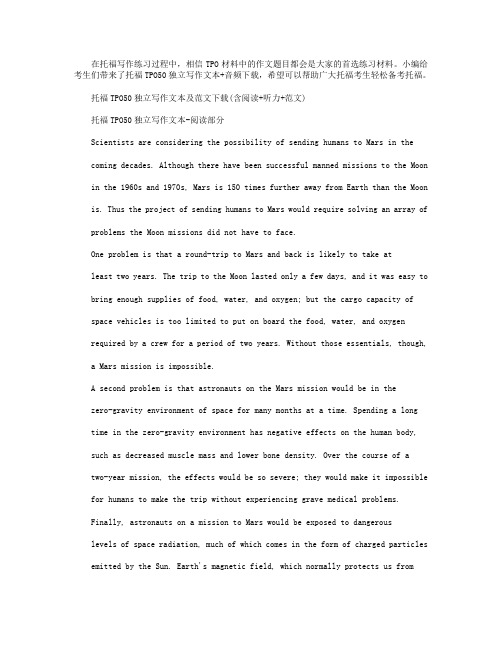
在托福写作练习过程中,相信TPO材料中的作文题目都会是大家的首选练习材料。
小编给考生们带来了托福TPO50独立写作文本+音频下载,希望可以帮助广大托福考生轻松备考托福。
托福TPO50独立写作文本及范文下载(含阅读+听力+范文)托福TPO50独立写作文本-阅读部分Scientists are considering the possibility of sending humans to Mars in thecoming decades. Although there have been successful manned missions to the Moonin the 1960s and 1970s, Mars is 150 times further away from Earth than the Moonis. Thus the project of sending humans to Mars would require solving an array ofproblems the Moon missions did not have to face.One problem is that a round-trip to Mars and back is likely to take atleast two years. The trip to the Moon lasted only a few days, and it was easy tobring enough supplies of food, water, and oxygen; but the cargo capacity ofspace vehicles is too limited to put on board the food, water, and oxygenrequired by a crew for a period of two years. Without those essentials, though,a Mars mission is impossible.A second problem is that astronauts on the Mars mission would be in thezero-gravity environment of space for many months at a time. Spending a longtime in the zero-gravity environment has negative effects on the human body,such as decreased muscle mass and lower bone density. Over the course of atwo-year mission, the effects would be so severe; they would make it impossiblefor humans to make the trip without experiencing grave medical problems.Finally, astronauts on a mission to Mars would be exposed to dangerouslevels of space radiation, much of which comes in the form of charged particlesemitted by the Sun. Earth's magnetic field, which normally protects us fromdangerous solar radiation, would not be able to protect a spaceship traveling in interplanetary space. Constructing a shield that would protect the wholespaceship from space radiation is at present impossible because it would add too much weight to the ship.Directions: You have 20 minutes to plan and write your response. Yourresponse will be judged on the basis of the quality of your writing and on how well your response presents the points in the lecture and their relationship to the reading passage. Typically, an effective response will be 150 to 225words.Summarize the points made in the lecture, being sure to explain how theyrespond to the specific concerns presented in the reading passage.托福TPO50独立写作文本-听力音频TASK2Do you agree or disagree with the following statement? All universitystudents should be required to take history courses no matter what their field of study is. Use specific reasons and examples to support your answer.托福TPO50独立写作文本-听力音频下载链接:百度网盘链接:/s/1nvDS2Jf 密码:2frh以上就是小编为大家带来关于托福TPO写作资料供大家阅读参考,托福资料频道将第一时间为考生发布最全、最新、最专业的托福资讯及托福考试资料及机经.。
托福TPO50综合写作阅读原文+听力原文+满分范文
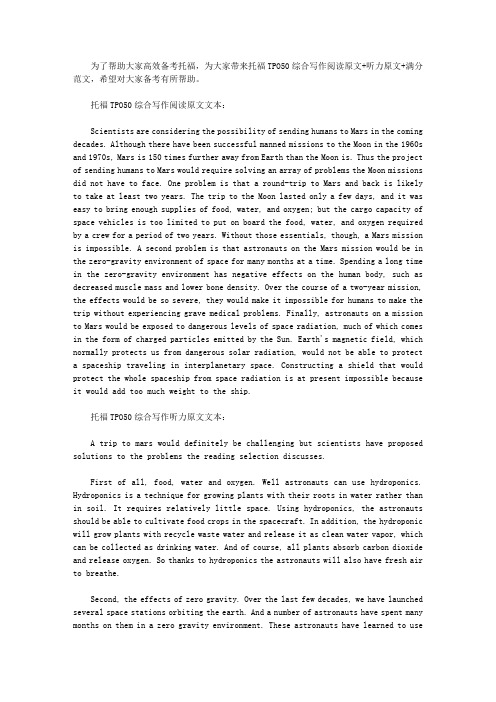
为了帮助大家高效备考托福,为大家带来托福TPO50综合写作阅读原文+听力原文+满分范文,希望对大家备考有所帮助。
托福TPO50综合写作阅读原文文本: Scientists are considering the possibility of sending humans to Mars in the coming decades. Although there have been successful manned missions to the Moon in the 1960s and 1970s, Mars is 150 times further away from Earth than the Moon is. Thus the project of sending humans to Mars would require solving an array of problems the Moon missions did not have to face. One problem is that a round-trip to Mars and back is likely to take at least two years. The trip to the Moon lasted only a few days, and it was easy to bring enough supplies of food, water, and oxygen; but the cargo capacity of space vehicles is too limited to put on board the food, water, and oxygen required by a crew for a period of two years. Without those essentials, though, a Mars mission is impossible. A second problem is that astronauts on the Mars mission would be in the zero-gravity environment of space for many months at a time. Spending a long time in the zero-gravity environment has negative effects on the human body, such as decreased muscle mass and lower bone density. Over the course of a two-year mission, the effects would be so severe, they would make it impossible for humans to make the trip without experiencing grave medical problems. Finally, astronauts on a mission to Mars would be exposed to dangerous levels of space radiation, much of which comes in the form of charged particles emitted by the Sun. Earth's magnetic field, which normally protects us from dangerous solar radiation, would not be able to protect a spaceship traveling in interplanetary space. Constructing a shield that would protect the whole spaceship from space radiation is at present impossible because it would add too much weight to the ship. 托福TPO50综合写作听力原文文本: A trip to mars would definitely be challenging but scientists have proposed solutions to the problems the reading selection discusses. First of all, food, water and oxygen. Well astronauts can use hydroponics. Hydroponics is a technique for growing plants with their roots in water rather than in soil. It requires relatively little space. Using hydroponics, the astronauts should be able to cultivate food crops in the spacecraft. In addition, the hydroponic will grow plants with recycle waste water and release it as clean water vapor, which can be collected as drinking water. And of course, all plants absorb carbon dioxide and release oxygen. So thanks to hydroponics the astronauts will also have fresh air to breathe. Second, the effects of zero gravity. Over the last few decades, we have launched several space stations orbiting the earth. And a number of astronauts have spent many months on them in a zero gravity environment. These astronauts have learned to useseveral techniques to safely manage the effects of zero gravity. For example, regular exercise prevents the decrease in muscle mass. Likewise, taking vitamins and minerals like calcium slows down the decrease in astronauts’ bone density. Third, solar radiation. Astronauts traveling to Mars will be exposed to some solar radiation but this radiation will not be at dangerous levels all the time. The sun only releases dangerous amounts of radiation occasionally, during periods when it is particularly active. In order to avoid this threat, the spacecraft could be equipped with special instruments that monitor solar radiation and with a small shelter that shield against radiation but doesn’t add much weight to the ship. Most of the time, the astronauts will go about their normal business in unshielded areas of the spacecraft. But when their instruments detect increased radiation, they could stay in the small shielded area until the danger has passed. 托福TPO50综合写作满分范文: Both the reading and listening are arguing over a question whether it is possible to send human being to Mars. The reading lists out three problems to a successful carrying out. However, the listening offers three solutions to these questions. First, the reading raises the question that it takes too long to send people to Mars, approximately two years and no spacecraft could take that many loads of food, water and life essentials. Instead, the listening says this is not a real problem since the astronauts could use hydroponics to grow crop plants in water and food will not be an obstacle. Also, they could grow plants with recycle waste water and reuse it as clean water vapor, which could be drunk. Plus, since all plants do photosynthesis, the astronauts could breathe fresh air released by them. Second, the reading asserts that living in a zero-gravity environment would exert a negative effect on one’s health. Nevertheless, the professor says that the astronauts have learned to use several techniques to make up for the health issue. They will do regular exercise to prevent muscle mass from decreasing and take vitamins and minerals to slow down problem with their bone density. In another word, they’ve figured out how to cope with the potential health problem. Third, the reading claims that radiation emitted by the sun would be dangerous to astronauts. This time professor subtly rejects by pointing out that a third solution has come out. The spaceship would be equipped with a special instrument to monitor the radiation. What’s more, the device could also shield against the radiation. When astronauts meet the period of a large amount of radiation, they could hide behind the shielded areas and come out when the danger has passed. 以上是给大家整理的托福TPO50综合写作阅读原文+听力原文+满分范文,希望对你有所帮助!。
托福考试2024听力历年真题答案解析

托福考试2024听力历年真题答案解析2024年的托福考试听力部分,如往年一样,包含了一系列听力材料和相关问题。
本文将对历年真题中的听力部分进行题目解析和答案解释,以帮助考生更好地备考。
[介绍段]在托福考试听力部分,考生需要听取一段语音材料,然后回答几个与材料相关的问题。
这些材料可以是学术讲座、对话、课堂讨论等。
对于每种材料,考生需要仔细倾听,并在听完后选择正确的答案。
以下是对几个典型历年真题的解析。
[题目一]Question: What is the main topic of the lecture?听力材料:一段讲座内容,讲述关于生态系统中濒临灭绝的物种。
解析:这道题目需要考生仔细倾听讲座内容,判断讲座的主要话题。
在听力材料中,讲师提到了一系列与生态系统和濒临灭绝物种相关的信息。
考生需要筛选出这些信息并进行归纳,最终选择与之相关的答案。
答案解释:主要讲座话题是关于生态系统中濒临灭绝的物种。
在听力材料中,讲师提到了研究人员进行调查、濒临灭绝物种对生态系统的重要性等相关内容。
因此,正确答案应选择与这个主题相关的选项。
[题目二]Question: What is the relationship between the two speakers?听力材料:一段对话,讨论两位发言者的关系。
解析:这道题目需要考生仔细研究对话内容,判断两位发言者之间的关系。
在对话中,两位发言者可能会透露出彼此之间的身份、职位或熟悉程度等信息。
考生需要根据对话内容进行分析,并选择最符合描述的答案。
答案解释:根据对话中的内容,我们可以推断出两位发言者是一位教授和一位学生。
在对话中,教授提到了自己的研究、学生的作业等相关内容,这表明教授与学生之间存在一种教育关系。
[题目三]Question: What is the purpose of the conversation?听力材料:一段对话,讨论对话的目的。
解析:这道题目需要考生理解对话中的目的或主要内容。
托福听力tpo51 lecture1、2、3、4 原文+题目+答案+译文

托福听力tpo51lecture1、2、3、4原文+题目+答案+译文Lecture1 (1)原文 (1)题目 (3)答案 (5)译文 (6)Lecture2 (7)原文 (7)题目 (10)答案 (12)译文 (12)Lecture3 (14)原文 (14)题目 (16)答案 (18)译文 (18)Lecture4 (20)原文 (20)题目 (22)答案 (24)译文 (24)Lecture1原文NARRATOR:Listen to part of a lecture in a botany class.FEMALE PROFESSOR:So,continuing with crop domestication,and corn—or,um, maize,as it's often called.Obviously it's one of the world's most important cropstoday.It's such a big part of the diet in so many countries,and it's got so many different uses,that it's hard to imagine a world without it.But because it doesn't grow naturally,without human cultivation,and because there's no obvious wild relative of maize…uh,well,for the longest time,researchers weren’t able to find any clear link between maize and other living plants.And that's made it hard for them to trace the history of maize.Now,scientific theories about the origins of maize first started coming out in the 1930s.One involved a plant called teosinte.Teosinte is a tall grass that grows wild in certain parts of Mexico and Guatemala.When researchers first started looking at wild teosinte plants,they thought there was a chance that the two plants—um, maize and teosinte—were related.The young wild teosinte plant looks a lot like the corn plant,and the plants continue to resemble each other—at least superficially—even when they're developed.But when the scientists examined the fruits of the two plants,it was a different story. When you look at ripe corn,you see row upon row of juicy kernels…um,all those tiny little yellow squares that people eat.Fully grown teosinte,on the other hand, has a skinny stalk that holds only a dozen or so kernels behind a hard,um,almost stonelike casing.In fact,based on the appearance of its fruit,teosinte was initially considered to be a closer relative to rice than to maize.But there was one geneticist,named George Beadle,who didn't give up so easily on the idea that teosinte might be…well…the“parent”of corn.While still a student in the1930s,Beadle actually found that the two plants had very similar chromosomes—very similar genetic information.In fact,he was even able to make fertile hybrids between the two plants.In hybridization,you remember,the genes of two species of plants are mixed to produce a new,third plant—a hybrid.And if this offspring—this hybrid—is fertile,then that suggests that the two species are closely related genetically.This new,hybrid plant looked like an intermediate,right between maize and teosinte.So,Beadle concluded that maize must've been developed over many years,uh,that it is a domesticated form of teosinte.Many experts in thescientific community,however,remained unconvinced by his conclusions.They believed that,with so many apparent differences between the two plants,it would have been unlikely that ancient—that prehistoric peoples could’ve domesticated maize from teosinte.I mean,when you think about it,these people lived in small groups,and they had to be on the move constantly as the seasons changed.So for them to selectively breed,to have the patience to be able to pick out just the right plants…and gradually—over generations—separate out the durable,nutritious maize plant from the brittle teosinte that easily broke apart…it's a pretty impressive feat,and you can easily see why so many experts would have been skeptical.But,as it turns out,Beadle found even more evidence for his theory when he continued his experiments,producing new hybrids,to investigate the genetic relationship between teosinte and maize.Through these successive experiments,he calculated that only about five specific genes were responsible for the main differences between teosinte and maize—the plants were otherwise surprisingly similar genetically.And more recently,botanists have used modern DNA testing to scan plant samples collected from throughout the Western Hemisphere.This has allowed them to pinpoint where the domestication of maize most likely took place—and their research took them to a particular river valley in southern Mexico.They've also been able to estimate that the domestication of maize most likely occurred about9,000 years ago.And subsequent archaeological digs have confirmed this estimate.In one site,archaeologists uncovered a set of tools that were nearly9,000years old.And these tools were covered with a dusty residue…a residue of maize,as it turns out…thus making them the oldest physical evidence of maize that we've found so far.题目1.What is the lecture mainly about?A.A research study that compares wild and domesticated plantsB.Problems with a commonly held hypothesis about the origin of teosinteC.Reasons why wild plants are usually unsuitable for agricultureD.The process used to identify the ancestor of a modern crop2.What evidence seemed to indicate that maize and teosinte are not related?A.Young teosinte plants do not physically resemble young maize plants.B.Preliminary DNA evidence indicated that teosinte was related to rice.C.Maize and teosinte usually grow in significantly different climates.D.Maize and teosinte have very different types of kernels.3.Why does the professor discuss hybrids?A.To explain how a geneticist confirmed that maize was widely grown9,000years agoB.To indicate the earliest method used by geneticists to identify plant originsC.To explain a method used to demonstrate a link between two plant speciesD.To describe how geneticists distinguish between wild plants and domesticated plants4.What was most researchers'initial view of George Beadle's theory about teosinte?A.They accepted it but questioned the evidence cited.B.They rejected it because of conflicting archaeological evidence.C.They questioned it because it implies that ancient farmers were sophisticatedplant breeders.D.They questioned it because genetic research was viewed with skepticism at that time.5.What did Beadle conclude about maize and teosinte?A.Both plants lack particular genes that are common in most domesticated plants.B.Both plants have particular genes that enable them to adapt to varying climates.C.Only a small number of genes are responsible for the differences between the two plants.D.The genetic composition of both plants is very similar to that of rice.6.According to the professor,why was the discovery of stone tools important?A.It proved that teosinte was simultaneously domesticated in multiple locations.B.It helped to confirm the period in which maize was first domesticated.C.It suggested that maize required farming techniques that were more complex than experts had previously assumed.D.It provided evidence that maize plants were used for more purposes than experts had previously assumed.答案D D C C C B译文旁白:请听一段植物学讲座的节选。
托福听力 TPO听力题目与答案1-37全套汇总(附译文)
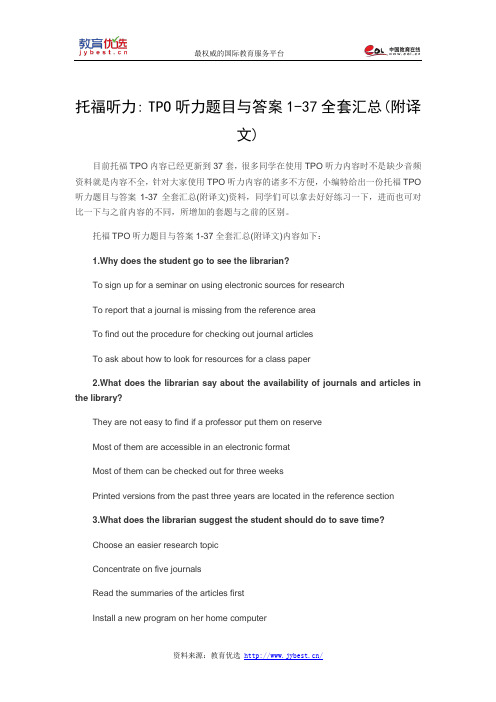
托福听力: TPO听力题目与答案1-37全套汇总(附译文)目前托福TPO内容已经更新到37套,很多同学在使用TPO听力内容时不是缺少音频资料就是内容不全,针对大家使用TPO听力内容的诸多不方便,小编特给出一份托福TPO 听力题目与答案1-37全套汇总(附译文)资料,同学们可以拿去好好练习一下,进而也可对比一下与之前内容的不同,所增加的套题与之前的区别。
托福TPO听力题目与答案1-37全套汇总(附译文)内容如下:1.Why does the student go to see the librarian?To sign up for a seminar on using electronic sources for researchTo report that a journal is missing from the reference areaTo find out the procedure for checking out journal articlesTo ask about how to look for resources for a class paper2.What does the librarian say about the availability of journals and articles in the library?They are not easy to find if a professor put them on reserveMost of them are accessible in an electronic formatMost of them can be checked out for three weeksPrinted versions from the past three years are located in the reference section3.What does the librarian suggest the student should do to save time?Choose an easier research topicConcentrate on five journalsRead the summaries of the articles firstInstall a new program on her home computer4.What can be inferred about why the woman decides to use the computer in the library?She thinks she might need additional help from the manShe does not have a computer at homeShe has to hand in her assignment by the end of the dayShe will be meeting a friend in the library later on5.Why does the woman say thisShe had forgotten about the informationShe is surprised she was not aware of the informationShe is annoyed that the information was published only recentlyShe is concerned that the librarian gave her incorrect informationStudentHi, um…, I really hope you can help me.LibrarianThat’s why I’m here. What can I do for you?StudentI’m supposed to do a literature review for my psychology course, but I’m… having a hard time finding articles. I don’t even know where to start looking.LibrarianYou said this is for your psychology course, right? So your focus is on …StudentDream Interpretation.LibrarianWell, you have a focus, so that’s already a good start. Hmmm… well, there’re a few things… oh wait… have you checked to see if your professor put any material for you to look at on reserve?StudentAha, that’s one thing I did know to do. I just copied an article, but I still need three more on my topic from three different journals.LibrarianLet’s get you going on looking for those then. We have printed versions of twenty or so psychology journals in the Reference Section. These are ones published within the last year. Now that I think about it… there’s a journal named Sleep and Dreams.StudentOh, yeah, the article I just copied is from that journal, so I’ve got to look in other sources.正确答案,D。
TPO听力50-L1L2题目
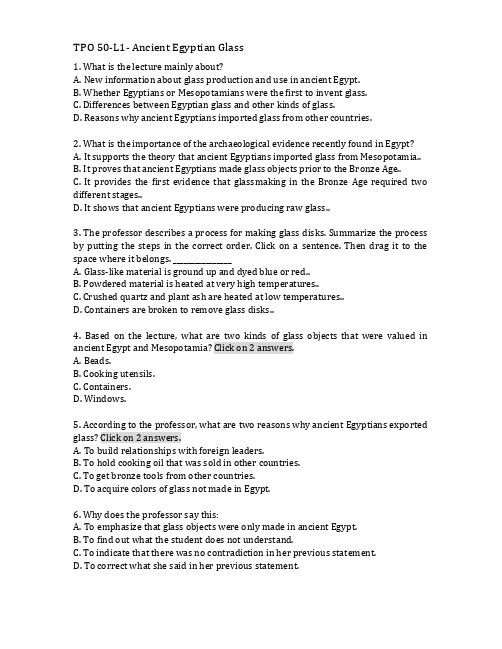
TPO 50-‐L1-‐ A ncient E gyptian G lass1. W hat i s t he l ecture m ainly a bout?A. N ew i nformation a bout g lass p roduction a nd u se i n a ncient E gypt.B. W hether E gyptians o r M esopotamians w ere t he f irst t o i nvent g lass.C. D ifferences b etween E gyptian g lass a nd o ther k inds o f g lass.D. R easons w hy a ncient E gyptians i mported g lass f rom o ther c ountries.2. W hat i s t he i mportance o f t he a rchaeological e vidence r ecently f ound i n E gypt?A. I t s upports t he t heory t hat a ncient E gyptians i mported g lass f rom M esopotamia..B. I t p roves t hat a ncient E gyptians m ade g lass o bjects p rior t o t he B ronze A ge..C. It provides the first evidence that glassmaking in the Bronze Age required two different s tages..D. I t s hows t hat a ncient E gyptians w ere p roducing r aw g lass..3. The professor describes a process for making glass disks. Summarize the process by putting the steps in the correct order. Click on a sentence. Then drag it to the space w here i t b elongs. ________________A. G lass-‐like m aterial i s g round u p a nd d yed b lue o r r ed..B. P owdered m aterial i s h eated a t v ery h igh t emperatures..C. C rushed q uartz a nd p lant a sh a re h eated a t l ow t emperatures..D. C ontainers a re b roken t o r emove g lass d isks..4. Based on the lecture, what are two kinds of glass objects that were valued in ancient E gypt a nd M esopotamia? C lick o n 2 a nswers.A. B eads.B. C ooking u tensils.C. C ontainers.D. W indows.5. A ccording t o t he p rofessor, w hat a re t wo r easons w hy a ncient E gyptians e xported glass? C lick o n 2 a nswers.A. T o b uild r elationships w ith f oreign l eaders.B. T o h old c ooking o il t hat w as s old i n o ther c ountries.C. T o g et b ronze t ools f rom o ther c ountries.D. T o a cquire c olors o f g lass n ot m ade i n E gypt.6. W hy d oes t he p rofessor s ay t his:A. T o e mphasize t hat g lass o bjects w ere o nly m ade i n a ncient E gypt.B. T o f ind o ut w hat t he s tudent d oes n ot u nderstand.C. T o i ndicate t hat t here w as n o c ontradiction i n h er p revious s tatement.D. T o c orrect w hat s he s aid i n h er p revious s tatement.TPO 50-‐L2-‐ T he C lassification O f C reatures1. W hat i s t he l ecture m ainly a bout?A. T he i mportance o f c lassifying l iving o rganisms.B. T he h istory o f b iological c lassification.C. T he i mpact o f t he m icroscope o n b iological c lassification.D. T he n aming o f n ewly d iscovered o rganisms.2. W hy d oes t he p rofessor d escribe “lumpers” a nd “splitters”?A. T o e mphasize o ne d ifference b etween e arly a nd m odern b iologists.B. To point out that early biological classifications were not based on scientific principles.C. T o g ive e xamples o f c ategories i n e arly b iological c lassification s ystems.D. To identify approaches that have shaped the development of biological classification s ystems.3. W hat c an b e i nferred a bout b iologists b efore t he t ime o f C arolus L innaeus?A. T hey d id n ot a gree o n t he n ames o f m any l iving t hings..B. V ery f ew o f t hem u sed m icroscopes..C. T hey w ere p uzzled b y t he d iscovery o f m icroorganisms t hat l acked a n ucleus..D. T hey h ad t o b e f luent i n s everal l anguages i n o rder t o p ublish t heir r esearch..4. W hat d oes t he p rofessor m ention a s t wo c haracteristics o f e xtremophiles?Click o n 2 a nswers.A. T hey l ive i n h arsh e nvironments..B. T hey a re m uch l arger t han m ost o ther t ypes o f b acteria..C. I n t heir s tructure t hey m ay r esemble v iruses..D. I n t heir b iochemistry, t hey m ay b e s imilar t o p lants a nd a nimals..5. What is the professor's attitude toward the current system of biological classification?A. S he i s s urprised t hat b iologists h ave n ot c hanged t he s ystem f or s o m any y ears..B. S he i s u pset t hat s o m any u nnecessary d istinctions h ave b een a dded..C. S he i s n ot c onfident t hat t he s ystem h as b een f inalized..D. S he i s e ager f or b iologists t o a dopt a c ompletely n ew s ystem..6. W hat d oes t he p rofessor i mply w hen s he s ays t his:A. The microscope was developed specifically for the purpose of studying and classifying m icroorganisms..B. The invention of the microscope enabled scientists to confirm predictions about the c haracteristics o f m icroorganisms..C. Organisms discovered with early microscopes were classified according to categories t hat A ristotle e stablished..D. M icroscopes h elped s cientists c larify d istinctions b etween t he p lant k ingdom a nd the a nimal k ingdom..。
托福TPO50听力Conversation1文本+题目+答案解析
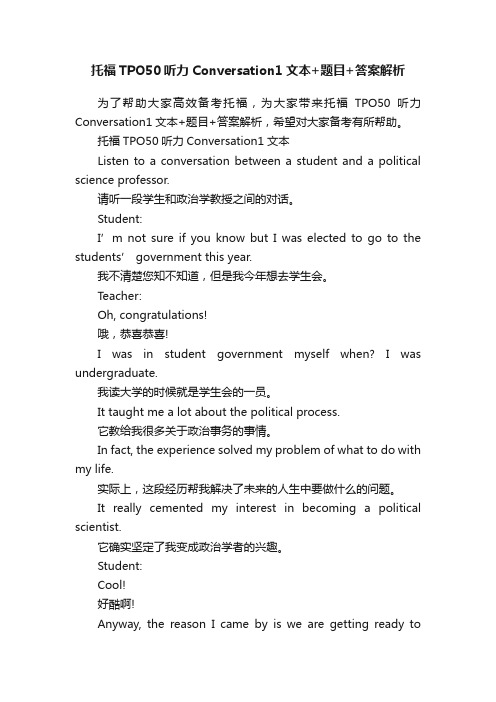
托福TPO50听力Conversation1文本+题目+答案解析为了帮助大家高效备考托福,为大家带来托福TPO50听力Conversation1文本+题目+答案解析,希望对大家备考有所帮助。
托福TPO50听力Conversation1文本Listen to a conversation between a student and a political science professor.请听一段学生和政治学教授之间的对话。
Student:I’m not sure if you know but I was elected to go to the students’ government this year.我不清楚您知不知道,但是我今年想去学生会。
Teacher:Oh, congratulations!哦,恭喜恭喜!I was in student government myself when? I was undergraduate.我读大学的时候就是学生会的一员。
It taught me a lot about the political process.它教给我很多关于政治事务的事情。
In fact, the experience solved my problem of what to do with my life.实际上,这段经历帮我解决了未来的人生中要做什么的问题。
It really cemented my interest in becoming a political scientist.它确实坚定了我变成政治学者的兴趣。
Student:Cool!好酷啊!Anyway, the reason I came by is we are getting ready toconduct a straw poll on campus, you know, hold an informal ballot since the general election is just a couple of month away.无论如何,我的理由是我们正在为大学里的非正式民意测验做准备,你知道,就是在大选几个月之前先举行一个非正式的投票。
托福听力tpo50 全套对话讲座原文+题目+答案+译文

托福听力tpo50全套对话讲座原文+题目+答案+译文Section1 (2)Conversation1 (2)原文 (2)题目 (4)答案 (5)译文 (5)Lecture1 (7)原文 (7)题目 (9)答案 (11)译文 (11)Lecture2 (13)原文 (13)题目 (15)答案 (17)译文 (18)Section2 (19)Conversation2 (19)原文 (19)题目 (21)答案 (23)译文 (23)Lecture3 (25)原文 (25)题目 (27)答案 (29)译文 (29)Lecture4 (31)原文 (31)题目 (33)答案 (35)译文 (36)Section1Conversation1原文NARRATOR:Listen to a conversation between a student and a political science professor.MALE STUDENT:I’m not sure if you know,but I was elected to student government this year…FEMALE PROFESSOR:Oh,congratulations!I was in student government myself as an undergraduate.It taught me a lot about the political process.In fact,the experience solved my problem of what to do with my life—it really cemented my interest in becoming a political scientist.MALE STUDENT:Cool.Anyway,um,the reason I came by is,we’re getting ready to conduct a straw poll on campus.You know,hold an informal vote,since the general election’s just a couple months away.We wanna get a feel for the student body’s political leanings.Like,who students are planning to vote for,which political party people identify with,that sorta thing.FEMALE PROFESSOR:Oh sure.I helped students run a straw poll once,years ago.It was a lotta work,mostly because we used paper ballots and stayed up all night counting‘em.But if you use computers.MALE STUDENT:Yeah,we’re creating a Web site for it where students’ll be able to vote online.Um,and we’re looking for a faculty advisor to help,actually.I was hoping you might be rested.FEMALE PROFESSOR:Oh,I’m flattered,John,but my schedule’s so jammed.I’m teaching two seminars,your intro course,finishing up my research…But,uh,what about Professor Klein?She’s new in our department.Plus,she’s a whiz with computers.MALE STUDENT:OK.I’ll ask her.FEMALE PROFESSOR:So,have you decided on a topic for your term paper yet?MALE STUDENT:Not really.FEMALE PROFESSOR:Why not write about your straw poll?Since the paper’s not due till after the election,you could include your results,maybe compare them with the real election results?MALE STUDENT:But would that be enough?I mean,just comparing numbers?FEMALE PROFESSOR:Well,no,you’d need to provide some analysis,too.But I was thinking—there’s a couple of local ballot questions this year,ya know,referenda that voters can either support or not support.MALE STUDENT:Right,there’s one on whether to ban smoking in restaurants,and another one,uh…I think it’s whether to spend tax dollars for a new sports arena in the city.FEMALE PROFESSOR:OK,here’s an idea…In regular elections,the vast majority of voters ignore referenda;they vote for their favorite candidates,but avoid ballot questions.We believe it’s because voters aren’t familiar with the questions or don’t understand them.But actively educating people on ballot questions right before they vote can improve referendum participation rates.MALE STUDENT:In that case,maybe we could have our straw-poll Web site provide information on the ballot questions,like how each proposal would affect students.FEMALE PROFESSOR:Exactly.And when you write your paper,you could compare the students’referendum voting rate to the general public’s,and include your own analysis of the results.Plus there’s plenty of published research on referendum voting behavior.MALE STUDENT:Thanks Professor Miller!I had no idea this straw poll could actually help me in my course work.题目1.Why does the man go to see the professor?A.To suggest an idea for his research projectB.To tell her about his election to student governmentC.To ask for her help on a political projectD.To discuss methods of gathering public opinion2.What is the professor's attitude toward her involvement in student government as an undergraduate?A.She is grateful that the experience helped inspire her career choice.B.She regrets that her involvement took time away from her studies.C.She wishes that she had been more active than she was.D.She is glad that her involvement enabled her to help other students.3.What is the student government's main reason for conducting a straw poll?A.To educate students on the candidates'positionsB.To remind students to vote in the upcoming electionC.To find out how students feel about the local referendaD.To get an idea of students'political preferences4.Why does the professor mention paper ballots?A.To show how a straw poll differs from an actual electionB.To stress the importance of keeping accurate recordsC.To indicate that conducting a poll may present challengesD.To suggest a way to improve communication between the student body and the student government5.Why does the professor discuss voting behavior on referenda?A.To encourage the man to vote on the local referendaB.To help the man develop a focus for his term paperC.To express her skepticism that voting behavior can be changedD.To let the man know about her current research project答案C AD C B译文旁白:请听一段学生和政治学教授之间的对话。
托福听力TPO50-L4-Petroleum
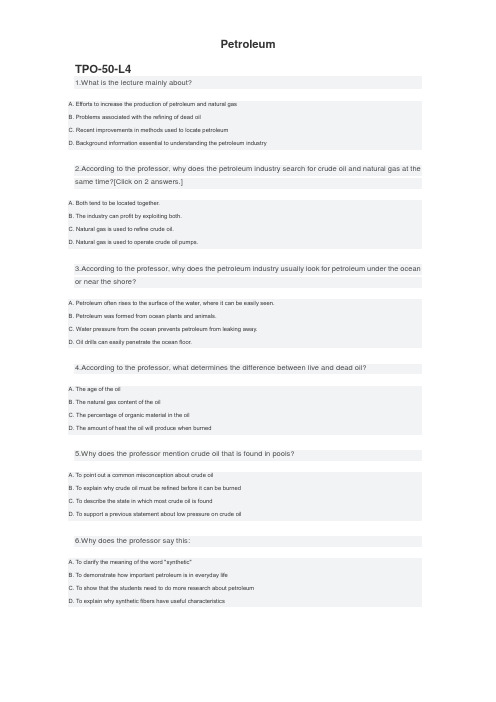
TPO-50-L41.What is the lecture mainly about?A. Efforts to increase the production of petroleum and natural gasB. Problems associated with the refining of dead oilC. Recent improvements in methods used to locate petroleumD. Background information essential to understanding the petroleum industry2.According to the professor, why does the petroleum industry search for crude oil and natural gas at the same time?[Click on 2 answers.]A. Both tend to be located together.B. The industry can profit by exploiting both.C. Natural gas is used to refine crude oil.D. Natural gas is used to operate crude oil pumps.3.According to the professor, why does the petroleum industry usually look for petroleum under the ocean or near the shore?A. Petroleum often rises to the surface of the water, where it can be easily seen.B. Petroleum was formed from ocean plants and animals.C. Water pressure from the ocean prevents petroleum from leaking away.D. Oil drills can easily penetrate the ocean floor.4.According to the professor, what determines the difference between live and dead oil?A. The age of the oilB. The natural gas content of the oilC. The percentage of organic material in the oilD. The amount of heat the oil will produce when burned5.Why does the professor mention crude oil that is found in pools?A. To point out a common misconception about crude oilB. To explain why crude oil must be refined before it can be burnedC. To describe the state in which most crude oil is foundD. To support a previous statement about low pressure on crude oil6.Why does the professor say this:A. To clarify the meaning of the word "synthetic"B. To demonstrate how important petroleum is in everyday lifeC. To show that the students need to do more research about petroleumD. To explain why synthetic fibers have useful characteristicsANSWERS:D/AB/B/B/A/BPetroleumListen to part of a lecture in a geology class.Professor: Hi, class, let’s get started. Um, last time we finished up the section of coal, so we have just two fossil fuels left to talk about. Those are petroleum and natural gas. Today I will concentrate on petroleum and we will get into natural gas tomorrow. Like coal and natural gas, petroleum has been formed over millions of years, from the remains of prehistoric plants and animals.And like coal and natural gas, it’s found in the rocks of Earth’s crusts.In fact, the word “petroleum” literally means “rock oil”.And in its’ original state, the way we find it in Earth’s c rust, it is called crude oil, sometime people will short it up, and just refer to it as crude.Um, petroleum also contains natural gas, so usually the petroleum industry is naturally searching for and utilizing deposits of both crude oil and natural gas at the same time. In other words, companies might as well gather, use and sell both the oil and the gas when they find it, since both are valuable.Ann?Student: But what kind of organic materials, I mean, specifically what kind of dead plants and animals make up petroleum exactly? Do you mean like trees and dinosaurs?Professor: Well, apparently petroleum is usually made from simple, one-celled marine animals and plants, algae, for example. Um, what happens is this accumulated plant and animal material that originally came from the ocean gets covered by sediment. And then is…um, eventually exposed to earth internal heat and pressure, for millions of years. And over those millions of years, the heat cooks and the pressure molds that material, turning it into a thick, sticky liquid. And since petroleum is made from these ocean organisms, you can guess where it was found, makes sense that we usually find it under the ocean or near shore, right? Yes, Ann?Ann: I’ve heard people talk of……ah……live and dead oils?Prof essor: Well, um, when crude oil has a lot of natural gas mixed up with it, it’s called live oil. But if the gas escapes from the mixture, then the oil is said to be dead. And it’s heavy and more difficult to pump. Does anyone know how the gas separates from the oil? Sam, go ahead.Sam: Doesn’t it happen when the oil shoots up to the surface?Professor: Yes, that’s right. When oil reaches the surface of the Earth, there is less pressure on it. And with less pressure, the oil and gas were able to separate. The other way the crude oil was able to come up to the surface is by people pumping it up out of the ground. And, um, it’s the same thing that happens at the surface, there is less pressure, and, so the oil and gas separate. But when we talked about how ita ctually exists inside earth’s crust, most people think that there are huge, pools of oil sitting around in caverns somewhere under there. That’s really rare. The majority of petroleum is just filling in the tiny pores and cracks in rocks.Now, um, a little more on the petroleum industry. As far as the extraction process the petroleum industry digs deep wells to reach underground oil fields where crude oil has accumulated over a large area and extract between layers of rocks. Then it pumps the crude oil out. Then its refineries have two main tasks,convert less valuable crude oil into a more valuable form and create usable products from refinedoil. Basically, the refiner will do this by boiling the oil.When the oil cools off, the stuff that is left is turned into a variety of products, like gasoline, diesel fuel for cars and trucks, asphalt for roads, um, paints, plastics, even soaps. And check what you’re wearing, if you are wearing something with synthetic fibers, what that really means is that it is made of the petroleum. So you can see petroleum is essential to today’s industrial society.Now, next week we will be joining graduate students from the department of petroleum engineering to examine the comprehensive field study they’re working on in our local oil fields. And I’d like you to read over the pack of information I’m about to hand out to you before we go. It should familiarize you with the history of the oil field we will be touring as well as the details of their project.。
托福听力tpo50 section2 对话讲座原文+题目+答案+译文

托福听力tpo50section2对话讲座原文+题目+答案+译文Conversation2 (1)原文 (1)题目 (3)答案 (5)译文 (5)Lecture3 (7)原文 (7)题目 (9)答案 (11)译文 (11)Lecture4 (13)原文 (13)题目 (15)答案 (17)译文 (17)Conversation2原文NARRATOR:Listen to a conversation between a student and the head of building maintenance.FEMALE HEAD OF MAINTENANCE:Can I help you?MALE STUDENT:Yeah,I,uh—I’m taking summer classes right now,and they’ve put me in Roberts dormitory,over by the library.FEMALE HEAD OF MAINTENANCE:OK…?MALE STUDENT:And I guess they’re,uh…painting the library,or doing something to the outside of the building…FEMALE HEAD OF MAINTENANCE:Ah,yes,they are—they’re replacing the bricks on the outside walls.MALE STUDENT:Well,whatever it is,it’s,like,really disturbing for those of us with windows facing the library—they’re working on the wall right opposite us.I mean, dust is everywhere,coming in the windows...and the noise…Cause we’re like,what, ten feet away,and,uh—well,it’s just not a pretty picture.FEMALE HEAD OF MAINTENANCE:Right,well that’s why we waited until now to start work on it.I mean,most students have already left campus for summer vacation…MALE STUDENT:Yeah,but Roberts Hall is being used by all the summer students.FEMALE HEAD OF MAINTENANCE:Really?Housing didn’t notify us of that.MALE STUDENT:Yeah,it’s pretty full!I mean,I can’t sleep at night’cause of the smell,and the dust,and…you know,I’d love to just,like,close the windows,but you know,being summer and all…FEMALE HEAD OF MAINTENANCE:Yes,I know,there’s no air-conditioning in that building…MALE STUDENT:Right.So,I mean—we’ve got five more weeks of classes left,and we were really wondering how much longer they’re going to be working on that particular wall…’Cause maybe,if it’s going to be a while,do you think they could maybe work on a different side of the building for now?One that’s not facing people’s dorm rooms?And wait till the students are gone to come back and finish this side?I mean,that way the dust and noise won’t be coming directly into our windows, while we’re here.FEMALE HEAD OF MAINTENANCE:You know,I wish it weren’t being done this way.Itdoesn’t make sense.But this particular decision was made by a special committee, and their plan was finalized several months ago.Uh,they just didn’t realize there’d be students in Roberts Hall now.MALE STUDENT:Yeah.FEMALE HEAD OF MAINTENANCE:Plus,uh…well,the equipment is all set up,y’know,the scaffolding up on that side of the building—well,it just wouldn’t be practical to have the construction workers move everything to another side,and leave a whole side of the library all torn up like that.MALE STUDENT:I guess not…Isn’t there another dorm open?Anywhere?FEMALE HEAD OF MAINTENANCE:Not that I know—oh,wait!I overheard someone saying today that Manchester Hall isn’t being used by the City Summer Camp after all.Y’know,most years they house their participants in that dorm all summer.MALE STUDENT:Well,there’s an idea…FEMALE HEAD OF MAINTENANCE:Now it’s a smaller dorm,and it’s a little out of the way,but,uh…I-I bet they could move the affected students from Roberts Hall.MALE STUDENT:Well,I think a lot of people would definitely appreciate that.FEMALE HEAD OF MAINTENANCE:OK,well…well let me call the housing people,and then I’ll get back to you.Leave me your name and number,OK?I’ll let you know what I find out.MALE STUDENT:Great!Thanks.题目1.What problem is the student having?A.His dormitory is in need of repairs.B.He does not have summer housing.C.He is bothered by construction on campus.D.He is not able to use the university library.2.What does the student suggest that the construction workers do?A.Stop their project until summer classes are overB.Start their work later in the dayC.Work on a different buildingD.Work on a different part of the library3.What does the woman imply about the construction plans?[Click on2answers]A.They cannot be changed at this point.B.It is unfortunate that they were approved.C.They have been changed several times already.D.They were not approved until very recently.4.What does the woman imply about moving students to another dormitory?A.She does not think it is necessary.B.She will need to get permission from the housing office.C.Students will have to wait until the dormitory is available.D.Students should contact the housing office for permission.5.What does the student imply when he says this:Student:Well,whatever it is,it’s like……really disturbing,for those of us with windows facing the library.They are working on the wall right opposite.I mean,dust is everywhere coming in the windows,and,the noise,cos we are like……what,ten feet away.And……well,it is just not a pretty picture.A.The new library walls are not very attractive.B.The view from the student's window is blocked by the construction.C.The construction is causing damage to nearby buildings.D.The construction is frustrating for many students.答案C D AB B D译文旁白:请听一段学生和建筑维护主管之间的对话。
托福听力TPO50-L2-The Classification of Creatures
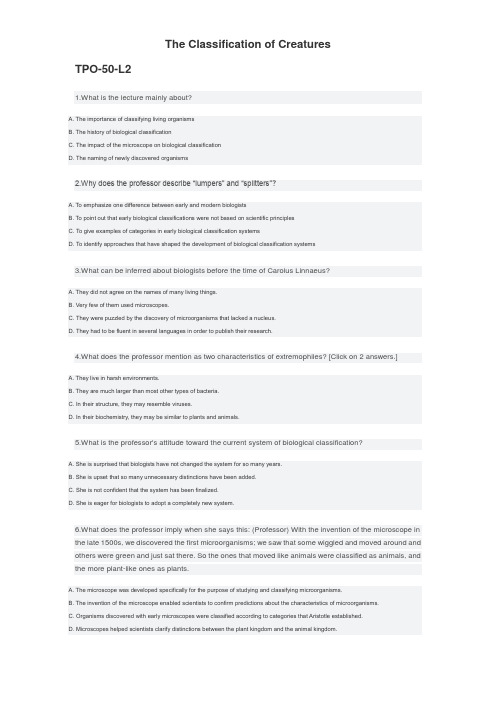
TPO-50-L21.What is the lecture mainly about?A. The importance of classifying living organismsB. The history of biological classificationC. The impact of the microscope on biological classificationD. The naming of newly discovered organisms2.Why does the professor describe “lumpers” and “splitters”?A. To emphasize one difference between early and modern biologistsB. To point out that early biological classifications were not based on scientific principlesC. To give examples of categories in early biological classification systemsD. To identify approaches that have shaped the development of biological classification systems3.What can be inferred about biologists before the time of Carolus Linnaeus?A. They did not agree on the names of many living things.B. Very few of them used microscopes.C. They were puzzled by the discovery of microorganisms that lacked a nucleus.D. They had to be fluent in several languages in order to publish their research.4.What does the professor mention as two characteristics of extremophiles? [Click on 2 answers.]A. They live in harsh environments.B. They are much larger than most other types of bacteria.C. In their structure, they may resemble viruses.D. In their biochemistry, they may be similar to plants and animals.5.What is the professor's attitude toward the current system of biological classification?A. She is surprised that biologists have not changed the system for so many years.B. She is upset that so many unnecessary distinctions have been added.C. She is not confident that the system has been finalized.D. She is eager for biologists to adopt a completely new system.6.What does the professor imply when she says this: (Professor) With the invention of the microscope in the late 1500s, we discovered the first microorganisms; we saw that some wiggled and moved around and others were green and just sat there. So the ones that moved like animals were classified as animals, and the more plant-like ones as plants.A. The microscope was developed specifically for the purpose of studying and classifying microorganisms.B. The invention of the microscope enabled scientists to confirm predictions about the characteristics of microorganisms.C. Organisms discovered with early microscopes were classified according to categories that Aristotle established.D. Microscopes helped scientists clarify distinctions between the plant kingdom and the animal kingdom.ANSWERS:B/D/A/AD/C/CThe Classification of CreaturesListen to part of a lecture in a biology class.Professor: Ok. There are two major types of classifiers in the world, people we call lumpers and people we call splitters. A lumper is someone who tries to put as many things as possible in one category. Splitters like to work for the differences and put things in as many different categories as possible.Both lumpers and splitters work in the business of defining biological classifications. The great philosopher Aristotle is generally considered the first person to systematically categorize things. He divided all living things into two groups. They were either animal or vegetable. And these categories are what biologists came to call “kingdoms”. So if it ran around, it was an animal, a member of the animal kingdom. And if it stood still, and grew in the soil, it was a plant, a member of the plant kingdom. This system, organizing all life into these two kingdoms, worked very well for quite a while, even into the age of the microscope.With the invention of the microscope, in the late 1500s, we discovered the first microorganisms. We thought that some wiggled and moved around and others were green and just sat there. So the ones that moved like animals were classified as animals, and the more plant-like ones as plants. Oh, before I go on I must mention Carolus Linnaeus. A hundred years or so after the invention of the microscope, Carolus Linnaeus devised a simple and practical system for classifying living things, according to the ranks of categorization still in use today——class, order, family and so on.And by far the best aspect of the Linnaeus system, is the general use of binomial nomenclature, having just two names to describe any living organism.This replaced the use of long descriptive names, as well as common names which vary from place to place and language to language. Binomial nomenclature gives every species a unique and stable two-word name, agreed upon by biologists worldwide.But not everything about this system remained unchanged. Take for example the mushroom, a fungus. It grew up from the ground and looked like a plant. So it was classified as a plant. But using the microscope we discovered that a fungus contains these microscopic thread-like cells that run all over the place. And so it’s actually not that plant-like. So in this case, the splitters eventually won, and got a third kingdom just for the fungus.And as microscopes improved, we discovered some microorganisms that were incredibly small. I’m talking about bacteria. And we could see that they didn’t have what we call a nucleus. So they got their own kingdom, a kingdom of very tiny things without nucleoli. So then we had several kingdoms for plants and for animals, and the different kinds of fungus like mushrooms, and for these tiny bacteria. But we also had some other microorganisms that didn’t fit anywhere. So biologist gave them their own kingdom. And this fifth kingdom was sort of anything that doesn’t fit in the first four kingdom, whi ch upset some people.And then there was a question of viruses. Viruses have some characteristics of life but don’t reproduce on their own or use energy. So we still don’t know what to do with them. The lumpers want to keep viruses in the current system. Some of the splitters say to give them a separate kingdom. And the extreme splitters say that viruses have nothing at all to do with living things and keep them out of my department.Recent research though has moved to see yet another direction. Nowadays when we want to determine the characteristics of something, we look at its biochemistry and its genetic material.[4:00.22] And what we’ve discovered is that some bacteria are not like the others. Many of these are called extremophiles. They live in very strange places, in polar ice or in a boiling water of hot springs or in water so salty (that) other organisms couldn’t live there. Extremophiles tend to have a different chemistry from other bacteria, a chemistry that in some case is actually more related to plants and animals than to previously known bacteria. So what to do with this strange bacteria?Well, one thing we’ve done is creating a new set of categories, the domains, overarching the different kingdoms. Biologists now recognize three domains. But even as we talk about these new domains, well, come back in a few years and it might all be different.。
托福TPO50听力Conversation1文本+题目+答案解析

为了帮助大家高效备考托福,为大家带来托福TPO50听力Conversation1文本+题目+答案解析,希望对大家备考有所帮助。
托福TPO50听力Conversation1文本 Listen to a conversation between a student and a political science professor. 请听一段学生和政治学教授之间的对话。
Student: I’m not sure if you know but I was elected to go to the students’ government this year. 我不清楚您知不知道,但是我今年想去学生会。
Teacher: Oh, congratulations! 哦,恭喜恭喜! I was in student government myself when? I was undergraduate. 我读大学的时候就是学生会的一员。
It taught me a lot about the political process. 它教给我很多关于政治事务的事情。
In fact, the experience solved my problem of what to do with my life. 实际上,这段经历帮我解决了未来的人生中要做什么的问题。
It really cemented my interest in becoming a political scientist. 它确实坚定了我变成政治学者的兴趣。
Student: Cool! 好酷啊! Anyway, the reason I came by is we are getting ready to conduct a straw poll on campus, you know, hold an informal ballot since the general election is just a couple of month away. 无论如何,我的理由是我们正在为大学里的非正式民意测验做准备,你知道,就是在大选几个月之前先举行一个非正式的投票。
tpo50三篇托福阅读TOEFL原文译文题目答案背景知识
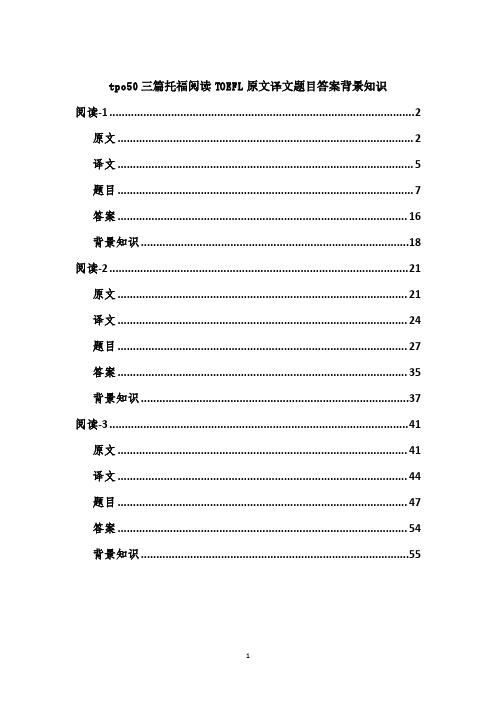
tpo50三篇托福阅读TOEFL原文译文题目答案背景知识阅读-1 (2)原文 (2)译文 (5)题目 (7)答案 (16)背景知识 (18)阅读-2 (21)原文 (21)译文 (24)题目 (27)答案 (35)背景知识 (37)阅读-3 (41)原文 (41)译文 (44)题目 (47)答案 (54)背景知识 (55)阅读-1原文American Railroads①In the United States,railroads spearheaded the second phase of the transportation revolution by overtaking the previous importance of canals.The mid-1800s saw a great expansion of American railroads. The major cities east of the Mississippi River were linked by a spiderweb of railroad tracks.Chicago's growth illustrates the impact of these rail links.In1849Chicago was a village of a few hundred people with virtually no rail service.By1860it had become a city of100,000, served by eleven railroads.Farmers to the north and west of Chicago no longer had to ship their grain,livestock,and dairy products down the Mississippi River to New Orleans;they could now ship their products directly east.Chicago supplanted New Orleans as the interior of America's main commercial hub.②The east-west rail lines stimulated the settlement and agricultural development of the Midwest.By1860Illinois,Indiana,and Wisconsin had replaced Ohio,Pennsylvania,and New York as the leading wheat-growing states.Enabling farmers to speed their products to the East,railroads increased the value of farmland and promotedadditional settlement.In turn,population growth in agricultural areas triggered industrial development in cities such as Chicago,Davenport (Iowa),and Minneapolis,for the new settlers needed lumber for fences and houses and mills to grind wheat into flour.③Railroads also propelled the growth of small towns along their routes.The Illinois Central Railroad,which had more track than any other railroad in1855,made money not only from its traffic but also from real estate speculation.Purchasing land for stations along its path, the Illinois Central then laid out towns around the stations.The selection of Manteno,Illinois,as a stop of the Illinois Central,for example,transformed the site from a crossroads without a single house in1854into a bustling town of nearly a thousand in1860, replete with hotels,lumberyards,grain elevators,and gristmills.By the Civil War(1861-1865),few thought of the railroad-linked Midwest as a frontier region or viewed its inhabitants as pioneers.④As the nation's first big business,the railroads transformed the conduct of business.During the early1830s,railroads,like canals, depended on financial aid from state governments.With the onset of economic depression in the late1830s,however,state governments scrapped overly ambitious railroad projects.Convinced that railroads burdened them with high taxes and blasted hopes,voters turnedagainst state aid,and in the early1840s,several states amended their constitutions to bar state funding for railroads and canals.The federal government took up some of the slack,but federal aid did not provide a major stimulus to railroads before1860.Rather,part of the burden of finance passed to city and county governments in agricultural areas that wanted to attract railroads.Such municipal governments,for example,often gave railroads rights-of-way,grants of land for stations, and public funds.⑤The dramatic expansion of the railroad network in the1850s, however,strained the financing capacity of local governments and required a turn toward private investment,which had never been absent from the picture.Well aware of the economic benefits of railroads,individuals living near them had long purchased railroad stock issued by governments and had directly bought stock in railroads, often paying by contributing their labor to building the railroads.But the large railroads of the1850s needed more capital than such small investors could generate.Gradually,the center of railroad financing shifted to New York City,and in fact,it was the railroad boom of the 1850s that helped make Wall Street in New York City the nation's greatest capital market.The stocks of all the leading railroads were traded on the floor of the New York Stock Exchange during the1850s. In addition,the growth of railroads turned New York City into thecenter of modern investment firms.The investment firms evaluated the stock of railroads in the smaller American cities and then found purchasers for these stocks in New York City,Philadelphia,Paris, London,Amsterdam,and Hamburg.Controlling the flow of funds to railroads,the investment bankers began to exert influence over the railroads'internal affairs by supervising administrative reorganizations in times of trouble.译文美国铁路①在美国,铁路超越了运河从前的重要性,成为运输革命第二阶段的先锋。
托福TPO50口语Task5听力文本+题目+满分范文
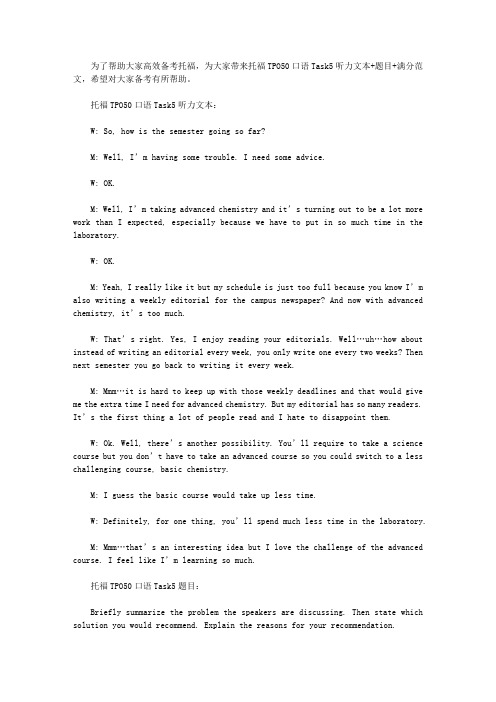
为了帮助大家高效备考托福,为大家带来托福TPO50口语Task5听力文本+题目+满分范文,希望对大家备考有所帮助。
托福TPO50口语Task5听力文本: W: So, how is the semester going so far? M: Well, I’m having some trouble. I need some advice. W: OK. M: Well, I’m taking advanced chemistry and it’s turning out to be a lot more work than I expected, especially because we have to put in so much time in the laboratory. W: OK. M: Yeah, I really like it but my schedule is just too full because you know I’m also writing a weekly editorial for the campus newspaper? And now with advanced chemistry, it’s too much. W: That’s right. Yes, I enjoy reading your editorials. Well…uh…how about instead of writing an editorial every week, you only write one every two weeks? Then next semester you go back to writing it every week. M: Mmm…it is hard to keep up with those weekly deadlines and that would give me the extra time I need for advanced chemistry. But my editorial has so many readers. It’s the first thing a lot of people read and I hate to disappoint them. W: Ok. Well, there’s another possibility. You’ll require to take a science course but you don’t have to take an advanced course so you could switch to a less challenging course, basic chemistry. M: I guess the basic course would take up less time. W: Definitely, for one thing, you’ll spend much less time in the laboratory. M: Mmm…that’s an interesting idea but I love the challenge of the advanced course. I feel like I’m learning so much. 托福TPO50口语Task5题目: Briefly summarize the problem the speakers are discussing. Then state which solution you would recommend. Explain the reasons for your recommendation. 托福TPO50口语Task5满分范文: In the conversation, the student is facing a problem that he is taking advanced chemistry course this semester but it takes him so much time that he doesn’t have any time left for his weekly editorial on school newspaper. There are two solutions. He could choose either to change the frequency into one editorial every two weeks or to take a less challenging course – basic chemistry. As far as I’m concerned, the former is a better choice since as a student it is much more important to put one’s focus on academic performance. Not writing editorials on school newspaper or writing less wouldn’t hurt him a lot. Instead, if he gets a low score on his course, he may not get a promising career after graduation and what’s worse he may not even graduate from his university, Therefore, because of this reason I suppose that the first solution is better. 以上是给大家整理的托福TPO50口语Task5听力文本+题目+满分范文,希望对你有所帮助!。
TPO50综合写作听力原文文本
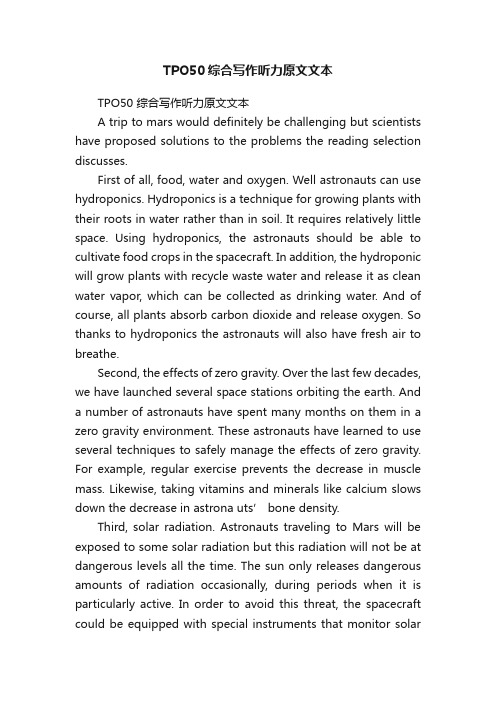
TPO50综合写作听力原文文本TPO50 综合写作听力原文文本A trip to mars would definitely be challenging but scientists have proposed solutions to the problems the reading selection discusses.First of all, food, water and oxygen. Well astronauts can use hydroponics. Hydroponics is a technique for growing plants with their roots in water rather than in soil. It requires relatively little space. Using hydroponics, the astronauts should be able to cultivate food crops in the spacecraft. In addition, the hydroponic will grow plants with recycle waste water and release it as clean water vapor, which can be collected as drinking water. And of course, all plants absorb carbon dioxide and release oxygen. So thanks to hydroponics the astronauts will also have fresh air to breathe.Second, the effects of zero gravity. Over the last few decades, we have launched several space stations orbiting the earth. And a number of astronauts have spent many months on them in a zero gravity environment. These astronauts have learned to use several techniques to safely manage the effects of zero gravity. For example, regular exercise prevents the decrease in muscle mass. Likewise, taking vitamins and minerals like calcium slows down t he decrease in astrona uts’ bone density.Third, solar radiation. Astronauts traveling to Mars will be exposed to some solar radiation but this radiation will not be at dangerous levels all the time. The sun only releases dangerous amounts of radiation occasionally, during periods when it is particularly active. In order to avoid this threat, the spacecraft could be equipped with special instruments that monitor solarradiation and with a small shelter that shield against radiation but doesn’t add much weig ht to the ship. Most of the time, the astronauts will go about their normal business in unshielded areas of the spacecraft. But when their instruments detect increased radiation, they could stay in the small shielded area until the danger has passed.。
托福TPO50口语Task6听力文本+题目+满分范文
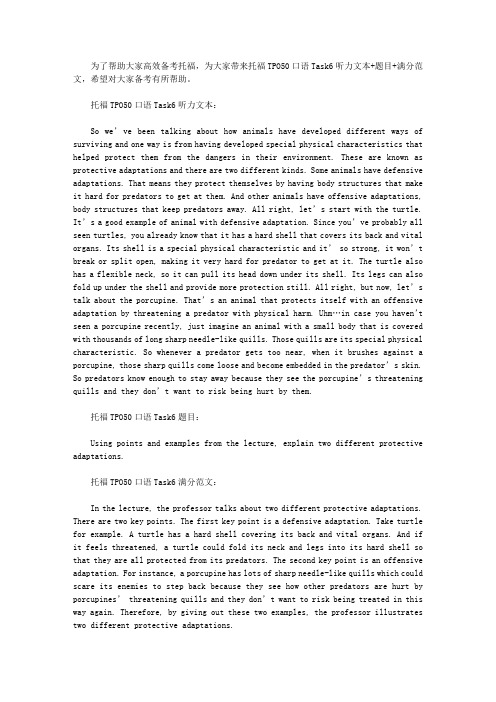
为了帮助大家高效备考托福,为大家带来托福TPO50口语Task6听力文本+题目+满分范文,希望对大家备考有所帮助。
托福TPO50口语Task6听力文本: So we’ve been talking about how animals have developed different ways of surviving and one way is from having developed special physical characteristics that helped protect them from the dangers in their environment. These are known as protective adaptations and there are two different kinds. Some animals have defensive adaptations. That means they protect themselves by having body structures that make it hard for predators to get at them. And other animals have offensive adaptations, body structures that keep predators away. All right, let’s start with the turtle. It’s a good example of animal with defensive adaptation. Since you’ve probably all seen turtles, you already know that it has a hard shell that covers its back and vital organs. Its shell is a special physical characteristic and it’ so strong, it won’t break or split open, making it very hard for predator to get at it. The turtle also has a flexible neck, so it can pull its head down under its shell. Its legs can also fold up under the shell and provide more protection still. All right, but now, let’s talk about the porcupine. That’s an animal that protects itself with an offensive adaptation by threatening a predator with physical harm. Uhm…in case you haven’t seen a porcupine recently, just imagine an animal with a small body that is covered with thousands of long sharp needle-like quills. Those quills are its special physical characteristic. So whenever a predator gets too near, when it brushes against a porcupine, those sharp quills come loose and become embedded in the predator’s skin. So predators know enough to stay away because they see the porcupine’s threatening quills and they don’t want to risk being hurt by them. 托福TPO50口语Task6题目: Using points and examples from the lecture, explain two different protective adaptations. 托福TPO50口语Task6满分范文: In the lecture, the professor talks about two different protective adaptations. There are two key points. The first key point is a defensive adaptation. Take turtle for example. A turtle has a hard shell covering its back and vital organs. And if it feels threatened, a turtle could fold its neck and legs into its hard shell so that they are all protected from its predators. The second key point is an offensive adaptation. For instance, a porcupine has lots of sharp needle-like quills which could scare its enemies to step back because they see how other predators are hurt by porcupines’ threatening quills and they don’t want to risk being treated in this way again. Therefore, by giving out these two examples, the professor illustrates two different protective adaptations. 以上是给大家整理的托福TPO50口语Task6听力文本+题目+满分范文,希望对你有所帮助!。
托福TPO50听力文本+答案+解析+音频下载(上)
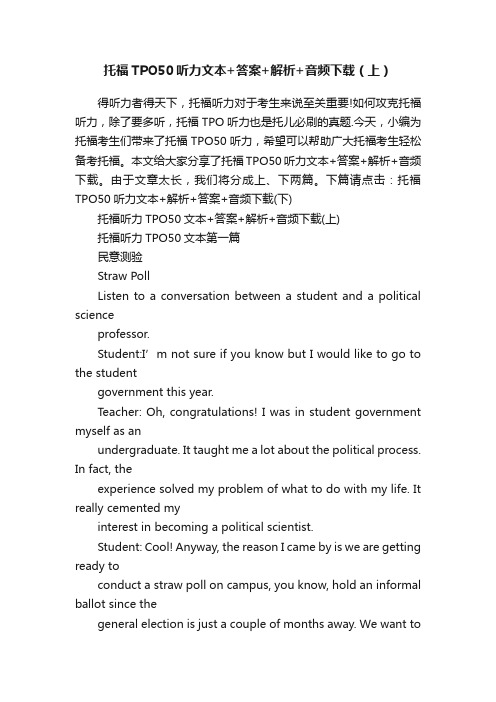
托福TPO50听力文本+答案+解析+音频下载(上)得听力者得天下,托福听力对于考生来说至关重要!如何攻克托福听力,除了要多听,托福TPO听力也是托儿必刷的真题.今天,小编为托福考生们带来了托福TPO50听力,希望可以帮助广大托福考生轻松备考托福。
本文给大家分享了托福TPO50听力文本+答案+解析+音频下载。
由于文章太长,我们将分成上、下两篇。
下篇请点击:托福TPO50听力文本+解析+答案+音频下载(下)托福听力TPO50文本+答案+解析+音频下载(上)托福听力TPO50文本第一篇民意测验Straw PollListen to a conversation between a student and a political scienceprofessor.Student:I’m not sure if you know but I would like to go to the studentgovernment this year.Teacher: Oh, congratulations! I was in student government myself as anundergraduate. It taught me a lot about the political process. In fact, theexperience solved my problem of what to do with my life. It really cemented myinterest in becoming a political scientist.Student: Cool! Anyway, the reason I came by is we are getting ready toconduct a straw poll on campus, you know, hold an informal ballot since thegeneral election is just a couple of months away. We want toget a field fromthe students' bodies political leanings, like who students are planning to votefor, which political party people identify with, that sort of thing.Teacher: I’m sure. I help students run the straw poll once years ago, uh,it was a lot of work. Mostly because we use paper ballots, and stayed up allnight counting them. But if you use computers……Student: Yeah, we are creating a website for our students to be able tovote online. Em, we are looking for a faculty advisor to help, actually. I was hoping you might be interested.Teacher: Oh, I’m flattered, John. But my schedule is so jammed. I’mteaching two seminars, your intro-course, finishing up my research. But, what about Professor Clan? She is new in our department. Plus, she is a wiz with computers.Student: Ok, I will ask her.Teacher: So, have you decided on the topic for your term paper yet?Student: Not really.Teacher: Why not write about your straw poll? Since the paper is not duetill after the election, you could include your results. Maybe compare them with the real election results.Student: But would that be enough? I mean, just comparing numbers?Teacher: Well, no, you need to provide some analysis, too.But I wasthinking, there is a couple of local ballot questions this year. You know, referenda, the voters can either support or not support?Student: Right. There is one on whether to ban smoking in restaurants, and another one……I think is whether to spend tax dollars for a new sports arena in the city.Teacher: Ah, Ok. Here is an idea. In regular elections, the vast majorityof voters ignore referenda. They vote for their favorite candidates but avoid ballot questions. We believe it's because voters aren’t familiar with the questions or don’t understand them. But actively educating people on ballot。
托福听力TPO50-L1-Ancient Egyptian Glass
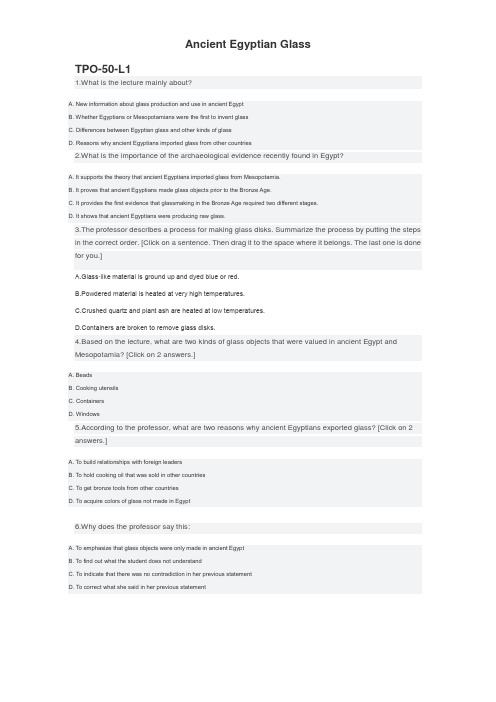
TPO-50-L11.What is the lecture mainly about?A. New information about glass production and use in ancient EgyptB. Whether Egyptians or Mesopotamians were the first to invent glassC. Differences between Egyptian glass and other kinds of glassD. Reasons why ancient Egyptians imported glass from other countries2.What is the importance of the archaeological evidence recently found in Egypt?A. It supports the theory that ancient Egyptians imported glass from Mesopotamia.B. It proves that ancient Egyptians made glass objects prior to the Bronze Age.C. It provides the first evidence that glassmaking in the Bronze Age required two different stages.D. It shows that ancient Egyptians were producing raw glass.3.The professor describes a process for making glass disks. Summarize the process by putting the steps in the correct order. [Click on a sentence. Then drag it to the space where it belongs. The last one is done for you.]A.Glass-like material is ground up and dyed blue or red.B.Powdered material is heated at very high temperatures.C.Crushed quartz and plant ash are heated at low temperatures.D.Containers are broken to remove glass disks.4.Based on the lecture, what are two kinds of glass objects that were valued in ancient Egypt and Mesopotamia? [Click on 2 answers.]A. BeadsB. Cooking utensilsC. ContainersD. Windows5.According to the professor, what are two reasons why ancient Egyptians exported glass? [Click on 2 answers.]A. To build relationships with foreign leadersB. To hold cooking oil that was sold in other countriesC. To get bronze tools from other countriesD. To acquire colors of glass not made in Egypt6.Why does the professor say this:A. To emphasize that glass objects were only made in ancient EgyptB. To find out what the student does not understandC. To indicate that there was no contradiction in her previous statementD. To correct what she said in her previous statementAnswers:A/D/CABD/AC/AD/CAncient Egyptian GlassListen to part of a lecture in an ancient history class.Professor: Ok, last time we were discussing trade and commerce during the Bronze Age. And I said a little over three thousand years ago, there was quite a lively trade among the countries along the Mediterranean Sea. People were making objects out of bronzes and they were using bronze tools to make other goods. And they developed trade networks to trade these goods with other countries around the Mediterranean. One of the things they traded was glass.And recently there was an archeological excavation in Egypt, on the Nile River around where it enters the Mediterranean Sea where they discovered an ancient glass factory. Robert?Robert: I thought our textbook said that the Egyptians imported their glass from other countries.Professor: Well, until now that’s what the evidence seemed to suggest. I mean, we had some evidence that suggested that the Egyptians were making glass objects, but not glass.Robert: Ok. Am……Am I missin g something? They are making glass but they are not making glass?Professor: I said they were making glass objects, right? You see, it was previously thought that they weren’t actually making the raw glass itself that they were importing unfinished glass f rom Mesopotamia, which today is a region consisting of Iraq and parts of Syria and Turkey and Iran, and simply reworking it. Most archeologists believed that the glass factories were in Mesopotamia because that’s where the oldest known glass remains come from. You see, there were two stages of glass making. The premiere production stage where they made disks of raw glass. And there was the secondary stage where they melted the raw glass, the glass disks, and created decorative objects, so, or whatever. And from this new Egyptian site, we learned that the primary production stage had several steps. First they took quartz, a colorless transparent mineral, and crushed it. Then they took that crushed quartz and mixed it with plant ash. A plant ash is just what it sounds like, the ashes left after you burnt plant material. They slowly heated this mixture at a relatively low temperature in small vessels, containers like jars made out of clay. And that yielded a kind of glassy material.They took this glassy material and grounded it up into a powder and then they used metallic dye to color it. After that, they poured the colored powder out into disk-shaped molds and heated it up to very high temperatures. So that it melted. After cooled, they break the molds, and inside there were the glass disks. These disks were shipped out to other sites within Egypt and places around the Mediterranean. Then in the secondary phase, the disks were reheated, and shaped into decorative objects. Susan?Susan: So what kind of objects were people making back then?Professor: Well, the most common objects we found, mostly in Egypt and Mesopotamia, the most common objects were beads. One thing Egyptians were very very good at was imitating precious stones. They created some beads that look so much like emeralds and pearls that it was very difficult to distinguish them from the real thing. Em, and……and also beautiful vessels, ah, with narrow necks. They were probably really valuable so they wouldn’t have been used to hold cooking oil or commo n food items. They were most likely used for expensive liquids, like perfume. Now the glass made at this factorywas mostly red, to get this red color they used copper, in a sophisticated process. Of course, any kind of glass was very valuable so these red bottles would only have been owned by wealthy people. In fact, because it was so difficult to make, and sort of mysterious and complicated, it was probably a product produced for the royal family. And they probably used glass to show their power. Also, beautiful expensive objects made great gifts if you are looking to establish or strengthen political alliances. And it is quite possible that the ancient Egyptians were actually exporting glass, not just making it or importing it. The trade with Mesopotamia was probably a friendly mutual trade because a Mesopotamia glass was usually white or yellow. So Mesopotamians might accept something like, we will give you two white disks for two red disks. There is no proof of that, at least not yet.。
- 1、下载文档前请自行甄别文档内容的完整性,平台不提供额外的编辑、内容补充、找答案等附加服务。
- 2、"仅部分预览"的文档,不可在线预览部分如存在完整性等问题,可反馈申请退款(可完整预览的文档不适用该条件!)。
- 3、如文档侵犯您的权益,请联系客服反馈,我们会尽快为您处理(人工客服工作时间:9:00-18:30)。
得听力者得天下,托福听力对于考生来说至关重要!如何攻克托福听力,除了要多听,托福TPO听力也是托儿必刷的真题.今天,小编为托福考生们带来了托福TPO50听力,希望可以帮助广大托福考生轻松备考托福。
本文给大家分享了托福TPO50听力文本+答案+解析+音频下载。
由于文章太长,我们将分成上、下两篇。
上篇请点击:托福TPO50听力文本+解析+答案+音频下载(上)
托福听力TPO50文本第四篇
Disturbance From Library Maintenance
图书馆修缮带来的困扰
Listen to a conversation between a student and the head of building
maintenance.
Teacher: Can I help you?
Student: Yeah, I um……I’m taking summer classes right now and they put me in
Robert’s Dormitory, offered by the library.
Teacher: Ok.
Student: And I guess they are painting the library or doing something to
the outside of the building?
Teacher: Ah……yes, they are. They are replacing the bricks on the outside
walls.
Student: Well, whatever it is, it’s like……really disturbing, for those of
us with windows facing the library. They are working on the wall right opposite
us. I mean, dust is everywhere coming in the windows, and, the noise, cos we are
like…… what, ten feet away. And……well, it is just not a pretty picture.
Teacher: Right, well, that’s why we waited until now to start work on it. I
mean, most students have already left campus for summer vacation.
Student: Yeah, but Robert’s Hall has been used by all the summer
students.
Teacher: Really? The housing didn’t notify us of that.
Student: Yeah. It’s pretty full. I mean, I can’t sleep at night, because of the smell and the dust and……You know, I’d love to just like close the windows but you know (it’s) being summer now.
Teacher: Yes, I know. There is no air-conditioning in that building.
Student: Right! So I mean, we got five more weeks of classes left, and we
were really wondering how much longer they are going to be working on that particular wall. Because maybe it’s going to be a while.Do you think they could maybe work on a different side of the building for now, one that's not facing people’s dorm rooms, and wait until the students are gone? To come back and finish this side? I mean, that way the dust and noise won’t be coming directly into our windows while we are here.
Teacher: You know, I wish it weren’t being done this way and it doesn’t make sense. But……this particular decision was made by a special committee and their plan was finalized several months ago. They just didn’t realize there would be students in Robert’s Hall now.
Student: Yeah.
Teacher: Plus, well, the equipment is all set up, you know, the scaffolding
is up on that side of the building and……oh it just won’t be practical to have the construction workers move everything to another side and leave a whole side of the library all torn out like that.
Student: I guess not. Isn’t there another dorm open anywhere?
Teacher: Not that I know. Oh, wait. I overheard someone saying today that。
